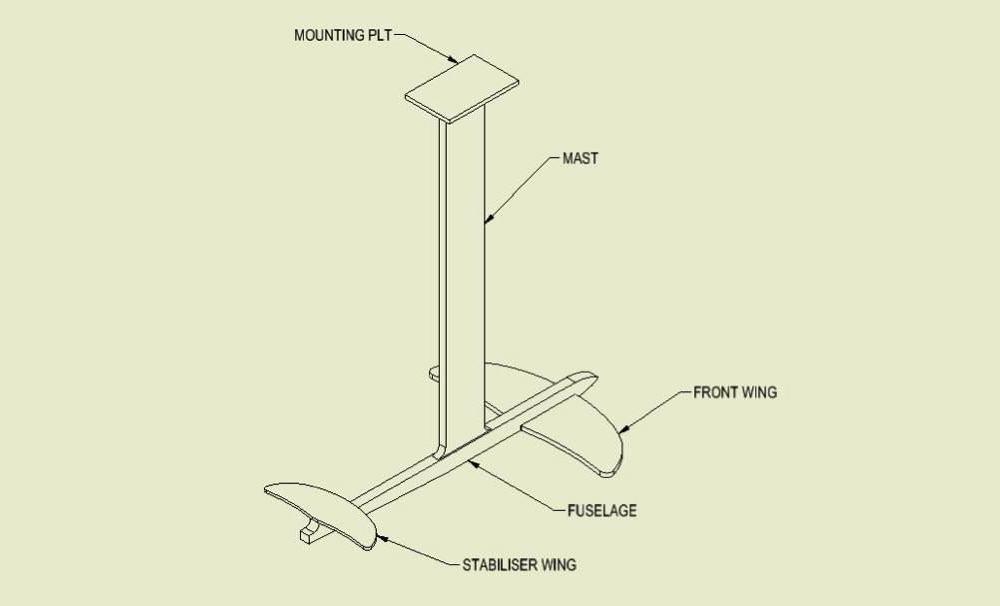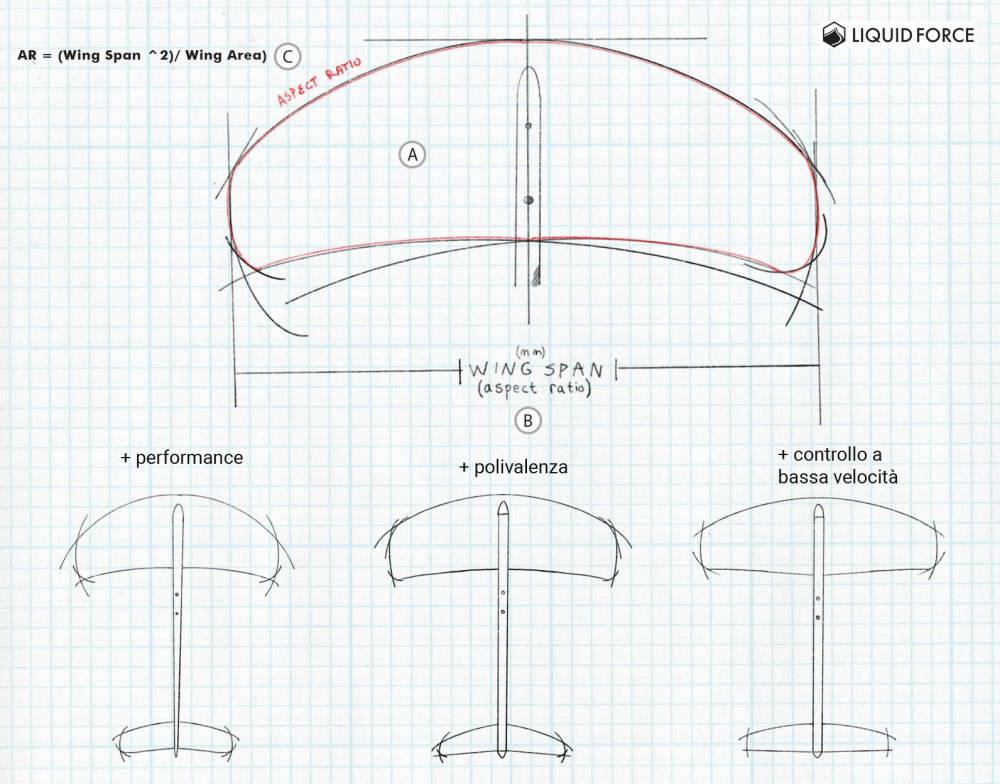Hydrofoil kitesurfing is an increasingly growing discipline, so after the post with our best tips for those who want to approach kitefoiling , we thought of putting together this guide with tips on choosing the most suitable equipment to start with kitefoiling.
The main features to focus on when choosing a hydrofoil are:
Mast height (MAST)
Front wing size and AR
Modularity
Materials
Edges of the wings
Price
Table characteristics
Let's first see some definitions, in order to better understand what are the parts that make up a hydrofoil.
A hydrofoil is made up of: a MAST also called a column or tree, a front wing (Front wing), a smaller rear wing (stabilizing wing), and a fuselage that connects them.

Simplifying, reaching a certain speed the front wing creates lift that makes the board and rider lift. In this way the friction with the water is drastically reduced, which is why the speed increases, while less wind is needed than to move forward with the whole board in the water.
How important are the measures in hydrophilicity?
A lot, indeed they are really fundamental. The height of the Mast and the size of the front wing are the key measures and are directly related to the behavior of your hydrofoil, and it is on these measures that you will have to concentrate on choosing your first hydrofoil.
Mast height in the kitefoil.
A taller Mast is more performing but also more difficult for a beginner to control.
For a first hydrofoil it may be a good idea to keep on a mast from about 45 - 60cm according to your skill. This is because the falls will be less dangerous and in general the difficulty is less with a lower Mast.
Once you have acquired a discreet control, you can switch to a Mast on 80 cm which is an excellent measure to do a little bit of everything.
The 1 meter masts are for riders who already have a good experience with foil and are looking for greater performance.
Front Wing size and AR for kitefoil.

The front wing is a key element on which to focus your attention when it comes to choosing your hydrofoil. Its shape, its size and consequently its bearing capacity directly influence the behavior of the foil.
Just like kitesurfing wings, in addition to the size, the AR ratio is very important. To learn it is better to choose a front wing with low AR that is more stable at low speed, so it is easier to learn and progress.
In principle, the smaller and narrower the front wing, the faster your foil will be, but it will need more speed to get up and will require more skill to control it while sailing. On the contrary, the wider the front wing, the more its lift and therefore its lift will increase, requiring less speed to float. In navigation, the foil with a wider wing is more stable and less dancer at low speeds, but will not reach the speeds of the most performing models.
Modularity of the kitefoil
The good news is that the various components of your hydrofoil are modular and as your ability progresses you can for example switch to a higher Mast or a narrower front wing, or maybe keep more than one front wing to change according to conditions. Of course when you make your first purchase you should check which components the brand you have chosen offers and, if necessary, its compatibility with components of other brands.
Kitefoil materials
Hydrofoil can be made with various materials that affect performance, durability and of course the price.
Carbon is generally used for high quality foils. Carbon has excellent qualities and allows to obtain extremely light and performing foils. On the other hand, we must say that carbon is certainly not cheap, so these foils are very expensive. Furthermore, they are also delicate and not very restful in case of accidental collisions, for example with the bottom.
Aluminum is widely used for mast and fuselage of foils as it is able to offer good value for money. Aluminum foils are certainly heavier than carbon ones and less performing, but also much cheaper. Aluminum also has the problem.
In addition, many brands also experiment with alloys and combinations of composite materials with glass and carbon fibers with the aim of combining performance and containing prices.
For a direct comparison between the pros and cons of a carbon foil versus an aluminum foil we advise you to read the appropriate post, in any case we can simplify saying that for the choice of the first hydrofoil it is not advisable to focus on carbon, but it is more appropriate to focus on aluminum and other alternative materials.
Edges of kitefoil wings
An aspect closely related to the material is that of the edges of the hydrophilic. Hydrofoils for beginners generally have slightly less sharp edges than high-performance models. This certainly affects the performance of the foil, but also significantly increases its safety, reducing the risk of accidental cuts and injuries.
Kitefoil price
Hydrofoil is expensive, there is no doubt about this and nobody would like to spend a fortune on his first hydrofoil. Our saving tips are:
1. choose an aluminum and non-carbon hydrofoil,
2. take a look at our kitesurf foil or second-hand offers.
Foilboard for kitefoiling
When you are a beginner with hydrofoil the size of the board is important, although many think otherwise because it should never touch the water. But things are different at the beginning and a big table is a great help. Make sure your board is large enough so you can get started easily. It is also very important to choose a board that has the possibility of having foot straps as they are strongly recommended for learning. Later on, many advanced riders prefer to take them off, but this will come with experience !.
Kitefoiling safety tips
The first advice that we feel we can give to those who approach hydrofoil kitesurfing for the first time is to take a few hours of lessons in a kitesurf school, not only to approach hydrofoiling safely but also to significantly speed up learning. A few hours may be enough to spare yourself many of the classic beginner mistakes and even a few accidents.
The second tip is to always wear helmet and impact jacket. As you will no doubt know, kitefoiling can be dangerous and it is not difficult to get hurt. Helmet and jacket are not optional
The third tip is to wear a long sleeve and leg wetsuit at least at the beginning. A wetsuit is not an effective protection for the worst accidents but can avoid many small accidental cuts and some bruises in which you run into during the first bodydrag with the foilil and during the first navigation tests.
In addition to this, of course, choose suitable conditions, not too strong wind, flat water, enough seabed ... and good foiling!
Pubblicato il 04 marzo 2020 | Blog > Equipments: KITESURF

